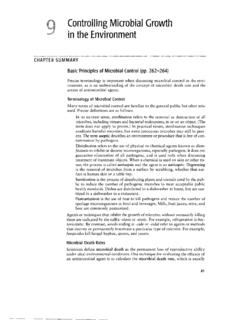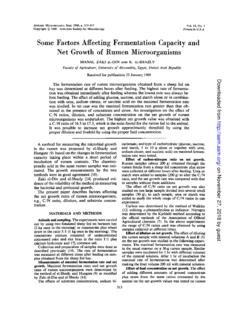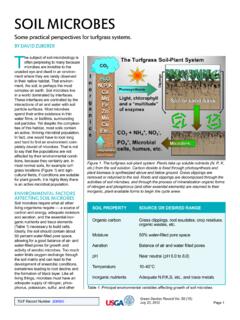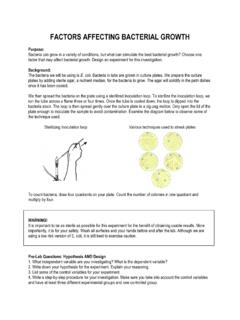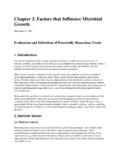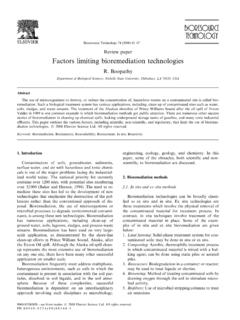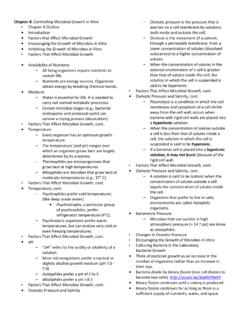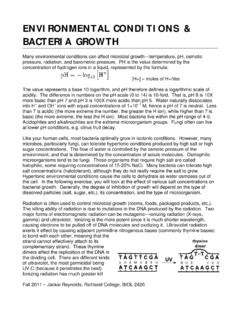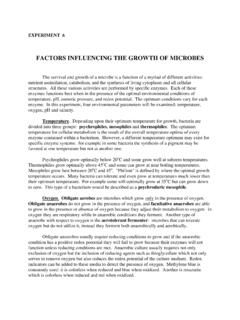Transcription of Intrinsicand extrinsic environmentalfoodfactors - agrobiology
1 VALIKI ntrinsicand extrinsicenvironmentalfoodfactorsWhatdo bacterianeedto grow?OutlinesFood processing -Food environment -Microorganisms aw T pH Cardinal valuesFactors affecting microbial growth /behaviour in foods Intrinsic factors extrinsic factors Implicit factors Processing factorsDetermine Type, extent and rate of microbial changes Shelf-life of foods Contribute to food safetyYou created this PDF from an application that is not licensed to print to novaPDF printer ( ) affecting microbial growth /behaviour in foods Intrinsic factors Nutrients pH and buffering capacity Redox potential Water activity Antimicrobial structures extrinsic factors Implicit factors Processing factorsFactors affecting microbial growth /behaviour in foods Intrinsic factors extrinsic factors Relative humidity Temperature Gazeous atmosphere Time Implicit factors Processing factorsFactors affecting microbial growth /behaviour in foods Intrinsic factors extrinsic factors Implicit factors Specific growth rate Synergism Antagonism Commensalism
2 Processing factorsYou created this PDF from an application that is not licensed to print to novaPDF printer ( ) affecting microbial growth /behaviour in foods Intrinsic factors extrinsic factors Implicit factors Processing factors Heat treatment Washing Packing Slicing IrradiationFactors affecting microbial growth /behaviour in foods Intrinsic factors extrinsic factors Implicit factors Processing factors Heat treatment Washing Packing Slicing IrradiationPROCESSING FACTORST echnology of production (washing, slicing, heat treatment, preservation, irradiation, packaging)
3 Transportation, StorageINTRINSIC factors awvalue pH Eh value Nutritive potential Structure Antimicrobial constituentsIMPLICIT factors Symbiosis Antagonism Competitivness Commensalism AntibiosisCOMPOSITION OF MICROFLORAEXTRINSIC factors Temperature Time Gaseous atmosphereFOOD SPOILAGE FOOD SUITABILITYFOOD SAFETY HAZARD FOOD SAFETYMULTIPLICATION / growth CONTROLYou created this PDF from an application that is not licensed to print to novaPDF printer
4 ( ) potential Abundance of nutrients Limiting ability/inability of utilization cereals vs. amylolytic enzymes Macromolecules Available key nutrients determine Extent Rate of microbial growth and metabolismWater activity/ aw-value Availability of water Related to osmotic pressure microbial osmoregulation Compatible solutes Polyols: glycerol, arabitol, manitol Most microorganisms grow well at aw> No microbial growth aw< depressionpoint freezing1001 TTaTERH ppwwa Water activity/ aw-valueWater activity affects behavior of microorganisms growth Sporulation Toxin production Survival during processing storage Recovery on agar media Chemical reactions Enzyme activityYou created this PDF from an application that is not licensed to print to novaPDF printer ( )
5 Aw-valueSpecific for speciesDepends on the factors Temperature pH Nutrient availability Antimicrobial substances Type of soluteaw -valueNaCl [% w/w] , *Minimum awfor growth of microorganismsRange of awMicroorganisms inhibited by lowest awin this rangeFoodsgenerally within this , Escherichia, Proteus, Shigella, Klebsiella, Bacillus, ClostridiumHighly perishable (fresh) foods and canned fruits, vegetables, meat, fish, and milk; cooked sausages and breads, foods containing 40 % (w/w)sucrose or 7% , V. parahaemolyticus, C. botulinum, Pediococcus, some molds, yeasts (Rhodotorula,Pichia)Some cheese (Chedar, Swiss, Provolone), cured meat (ham), some fruite juiceconcentrates, foods containing 55% (w/w) sucrose or 12 % NaClMinimum awfor growth of microorganismsRange of awMicroorganisms inhibited by lowest awin this rangeFoodsgenerally within this yeasts (Candida, Torulopsis, Hansenula), MicrococcusFermented sausages (salami), sponge cake, dry cheeses, margarine, foods containing 65 % (w/w)sucrose or 15% moulds (mycotoxigenic penicillia)
6 , Staphylococcusaureus, most Saccharomyces, DebaryomycesMost fruite juiceconcentrates, sweetened condesed milk, chocolate syrups, flour, rice, pulses containing 15-17% moisture, country-style ham, fondants, high-ratio cakesYou created this PDF from an application that is not licensed to print to novaPDF printer ( ) awfor growth of microorganismsRange of awMicroorganisms inhibited by lowest awin this rangeFoodsgenerally within this halophilic bacteria, mycotoxinogenic aspergilliJam, marmelade, moulds (Aspergillus chevalieri, A. candidus, Walemia sebi), Saccharomyces bisporusRolledoats containing approx.
7 10 % moisture, grained nugats, jelly, raw cane sugar, some dried fruits, yeasts (Zygosaccharomyces rouxii), fewmoulds (Aspergillus echinulatus, Monascus bisporus)Dried fruits containing 15-20 % moisture, some toffees and caramels, honeyMinimum awfor growth of microorganismsRange of awMicroorganisms inhibited by lowest awin this rangeFoodsgenerally within this microbial proliferationPasta containing 12% moisture, spices containing approx. 10% microbial proliferationWhole egg powder containing % microbial proliferationCookies, some crackers, etc.
8 Containing % microbial proliferationWhole milk powder containing 2-3% moisture. Dried vegetables ocntaining 5% moisture, corn flakes cont. 5% moisture, some crackersMinimal aw values for growthSpeciesMin awSpeciesMin awMost of bacteria> of moulds> botulinum terreusClostridium botulinum A, of yeasts> , , , , D two organisms adapted to a different awB, C different humectantRoss (1999)You created this PDF from an application that is not licensed to print to novaPDF printer ( ) aw values for growthaw= Meekin and Ross (1996)
9 Aw value for food storage Nuts water content 4-9 % Protein rich legumes 9-13 % the same aw-value Dried fruits 18-25 % aw> -a few days aw -two weeks av -two months av -two years av -no limitCritical water content value for food storage Dehydraed fruits 18-25 % Starch 18 % Dehydraed vegetables 14-20 % Milk powder15 % Dehydrated meat15 % Rice, wheat flour13-15 % Dehydrated whole eggs10-11 % Whole milk powder8 %You created this PDF from an application that is not licensed to print to novaPDF printer ( ) aw-value Direct methods Gravimetric method by Landroc and Proctor (1953) Instrumental methods rRH % Resistive electrolytic cell Capacitive measurement Indirect method Dew point Freezing pointAcidity/ pH -valuepH = -log (aH+) = log 1/ (aH+) log 1/[H+] Acidity/alkalinity affect stability of macromolecules Enzymes Growt and metabolism Fastest growth Bacteria -pH of Yeasts -pH of Filamentous fungi -pH of Range of pH value for growth of selected microorganisms A)Alcaligenes faecalis in brothB)In broth + % NaClC)
10 In broth + M Na citrateYou created this PDF from an application that is not licensed to print to novaPDF printer ( ) pH value for growth of selected microorganisms pH valueApproximatepH ranges of somecommonfoodcommodities141312111098765 432pHFermented sharkEgg whitefishmeatCitrus fruitsmilkSoft drinksflourvegetablesbeerpH value of the product Rate of food spoilage Character of food spoilage Vegetables moderately acid pH Soft-rot producing E. carotovora and pseudomonads Fruits lower pH Yeasts and molds dominate in spoilage Buffering capacity Important concentration of undissiociated weak acid You created this PDF from an application that is not licensed to print to novaPDF printer ( ) potential/ Eh-value Obr.
